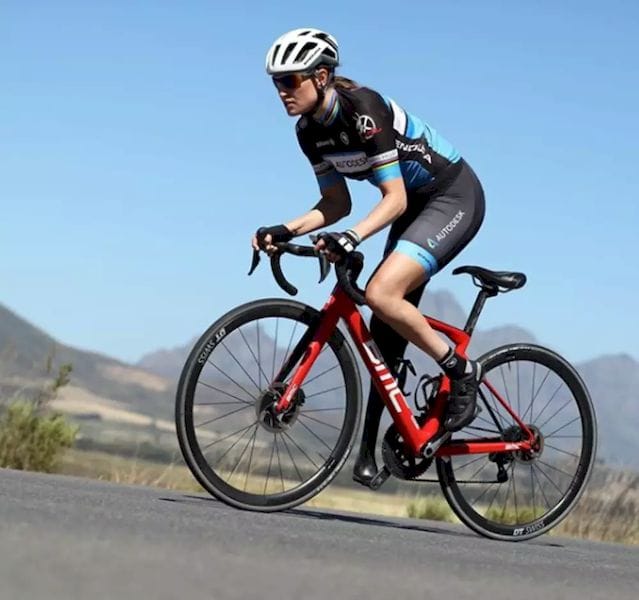
Recreational cyclists joke of biking their legs off after a hard ride.
It’s no joke to the professional cyclist on stage at Accelerate 2018, Paralympic champion Denise Schindler. The loss of a leg is as serious as a train accident, like the one she had when she was two years old and that resulted in an amputation below the knee for one leg and left the other in continual pain.
Schindler, now 32, rides a road bike and wins medals. She’s won silver and bronze for Germany in the 2016 Rio Paralympics, as well as silver in the 2012 London games. She has won the World Championship three times, which would qualify her as the top female cyclist with a disability on Earth. A world class athlete in an endurance sport makes for astounding biometrics: her resting heart rate is 42.
With her blue eyes, tawny hair and an at-ease smile, Denise is the woman you have to muster courage to approach. We do so under guise of an interview after her keynote. Looking across the table, it’s hard to imagine the hard charging, gritty athlete she must be, winner of many races, who has fought for and stood at the top of the podium—on one leg and a prosthetic.
![Denise Schindler, keynote speaker at Accelerate 2018 in Toronto. [Source: ENGINEERING.com]](https://fabbaloo.com/wp-content/uploads/2020/05/image-asset_img_5eb0a4a694b73.jpg)
From her accident at the age of two, Schindler’s childhood was anything but sporting. She ran but it hurt. “I could not run for very long,” she said. But one day, she finds herself in a gym class with stationary bikes.
“I was keeping up with everyone,” she says with a smile. She discovers cycling was something she could do with her severed leg and a prosthetic without pain. The smooth stroke of pedaling a bicycle was far gentler than running, where the impact of the ground sent a shock through the orthotic and into very sensitive living tissue.

On the stationary bike, Schindler finds her inner athlete. Anxious to try her new-found fitness on the road, she attempts the Bavarian Alps. She makes it, but barely. But it is a good pain, the pain of exertion, of accomplishment.
It wasn’t long before Schindler enters pro cycling, a demanding sport that places utmost demands on her lungs and legs. Schindler’s amputation is below the knee. Her muscles still have bone below the knee so the leg can flex and straighten with power, although the power is diminished.
Schindler estimates she loses as much as 30 percent of her power with the partial leg under the most strenuous exertion [a full sprint], but cruising along in the draft, she keeps up with anyone—even the German pro team.
Her bike is outfitted with dual power meter, one for each side, so she can monitor the difference. In the para-cycling, Schindler is classified as a C3, where C1 is the most disabled and C5 the least. “A cyclist missing a hand would be a C5,” says Schindler.
Read more at ENGINEERING.com











Healthcare 3D printing attempts to solve two problems that plague providing care: customization and cost.